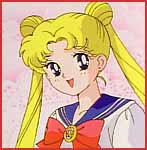by Sandy Yang
|
In 1995, five 14-year-old high school girls barged into an all-boys club. When they appeared on American network television that year, the teenagers of "Sailor Moon" didn't just thwart intergalactic villains but also the notion that animated heroes could only be boys.
The Japanese import transcended its cult status and challenged American audiences to watch an all-female cast of superheroes. Its popularity proved that girls didn't have to be the token love interest or the object of a rescue mission to get attention. "Sailor Moon" didn't just turn heads with its short skirts. Its complex characters and all-female cast set in a good vs. evil storyline staked new territory for female protagonists in US broadcast animation. Almost five years later, that first taste of American success has enabled Japan to import shoujo stories (girl-oriented stories) to a female audience largely unserved by the comic book industry -even with heroines in "Witchblade" and "Shi," whose sex appeal overshadows their positive female role model status. Today heroine-based works in network anime (WB's "Card Captors" and Fox's "Escaflowne"), cable cartoons (Cartoon Network's anime-influenced "Powerpuff Girls") and anime video releases ("Fushigi Yûgi," "Revolutionary Girl Utena") have started to fill that void. In several cases, these works attracted more boys than girls, challenging the archaic notion that girl cartoons can't appeal to everyone. For people within the industry who had been pushing these changes for years, the recognition "wasn't surprising, but gratifying," said VIZ's "Animerica Extra" editor Bill Flanagan in the VIZ panel at this year's San Diego Comic Con. "I knew it was going to happen especially with 'Sailor Moon' ... It got a lot of girls and guys to like shoujo." The Beginning Around the time of "Sailor Moon's" emergence, American comic book publishers were already interested in capturing the untapped female audience by bringing shoujo to the mainstream. Publisher and producer VIZ was the first US company to publish shoujo with the short-lived 1995 monthly comic "X/1999," which Manga Entertainment has sporadically released in US theaters. VIZ's monthly anthologies such as "Animerica," "Animerica Extra" and "Pulp" have included shoujo titles like "Fushigi Yûgi" and "Banana Fish." "Tokyo Pop" and its former incarnation "MIXX" magazine publish titles such as "Magic Knight Rayearth," "St. Tail" and "Miracle Girls." But the syndicated "Sailor Moon" transcended niche markets when it debuted in September 1995. It introduced America to five teenage girls who battle against inter-planetary villain Queen Beryl with the help of magical powers, a handsome stranger named Tuxedo Mask and some talking felines. In their effort to bring anime to mainstream American television, Burbank-based animation production company DIC initially sold "Sailor Moon" to 85 American programmers, who slotted it between the usual kiddie fare like "Sonic the Hedgehog" and "Captain Planet" all of which were being broadcast in the early morning. In these nascent stages, though, its unique character design and shoujo label made "Sailor Moon" a risk. "I have to say when we first took on 'Sailor Moon,' we knew it was going to be a challenge for our market place," says Robby London, executive vice president of creative affairs at DIC. But DIC took a chance after witnessing its popularity in so many other countries such as Italy, Spain and much of Asia. "Its track record of success in other places was so compelling that there must have been something about it that's magic ... It grabs people in a way I can't explain," London says. Today, the underdog reigns as "Sailor Moon" has gone on to garner millions of worldwide fans, who have devoted thousands of websites to the show. On American television, "Sailor Moon" rose to become the number one show with teens, gaining massive popularity on the Cartoon Network. Even the band Barenaked Ladies mentions the cartoon superheroes in their hit song "One Week." However, "Sailor Moon's" success came after several stations cancelled the syndicated series. But bad time slots never gave the show a chance to find an audience, according to Chris Hallowell, managing director of syndicator Program Exchange, who found the cult favorite a fitting venue on the Cartoon Network. "It's a difficult market, and it did as well as (programmers) thought," Hallowell says. "'Sailor Moon' didn't have the casual fans that inflate rating numbers; it has the avid fans - it doesn't show up that somebody's much more personally invested in the show in the numbers necesarily, it showed up on the stations' switchboards when they started to take it off and fans started to call in and write letters." |

